Phân tích nghĩa liên nhân trong chuyên mục phản hồi của độc giả gửi ban biên tập bằng tiếng Anh và tiếng Việt theo thuyết Đánh giá
Bài báo này nghiên cứu nghĩa liên nhân trong chuyên mục phản hồi của độc giả gửi ban biên tập bằng tiếng Anh và tiếng Việt. Thông qua việc sử dụng thuyết đánh giá, tập trung vào việc phân tích tập các chức năng ngôn ngữ để xử lý dữ liệu gồm 100 mẫu thư gửi cho ban biên tập. Hệ thống Thái độ đã được sử dụng để tìm ra những điểm giống và khác nhau trong cách hiểu ý nghĩa giữa các cá nhân trong các thư tiếng Anh (ELTEs) và thư tiếng Việt (VLTE). Kết quả của nghiên cứu cho thấy xét về tần suất của các giá trị Thái độ trong hai bộ dữ liệu, người viết tiếng Anh và tiếng Việt đều sử dụng một loạt ba hệ thống Thái độ trong các bức thư của họ. Thứ tự cao thấp của các hệ thống thái độ này được xếp như sau: Sự đánh giá cao, Sự phán xét, Sự ảnh hưởng. Liên quan đến các nguồn ngôn ngữ đánh giá được người viết lựa chọn với mục đích làm nổi bật nghĩa liên nhân, nghiên cứu cho thấy rằng thư tiếng Anh và tiếng Việt gửi cho các biên tập viên có một số điểm tương đồng về mức độ dùng các loại từ khác nhau để truyền tải cảm xúc. Thông qua phân tích Ảnh hưởng, Phán xét và Đánh giá cao, những điểm giống và khác nhau giữa ELTE và VLTE kết quả có thể sử dụng để xây dựng các nghĩa liên nhân khác nhau
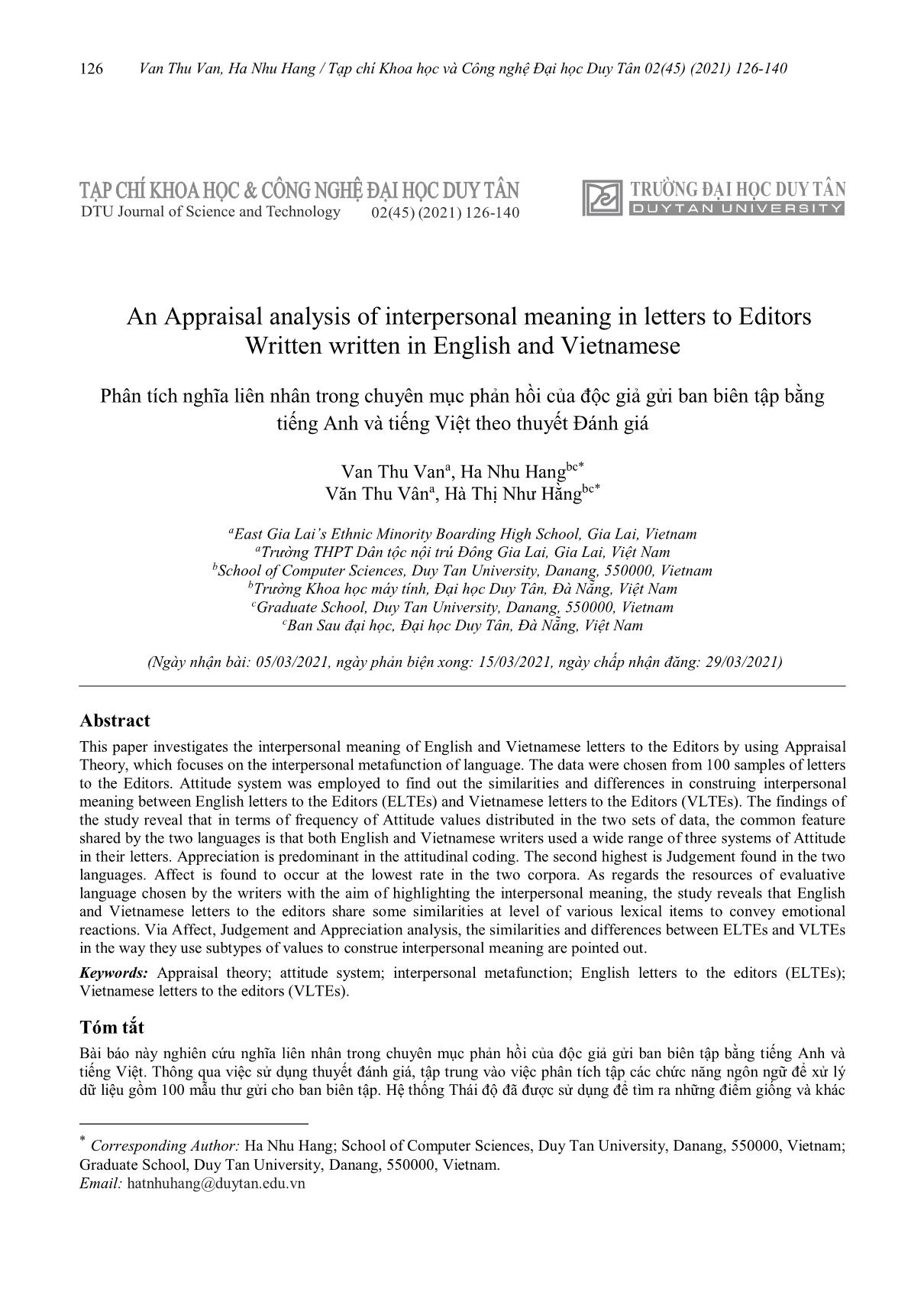
Trang 1
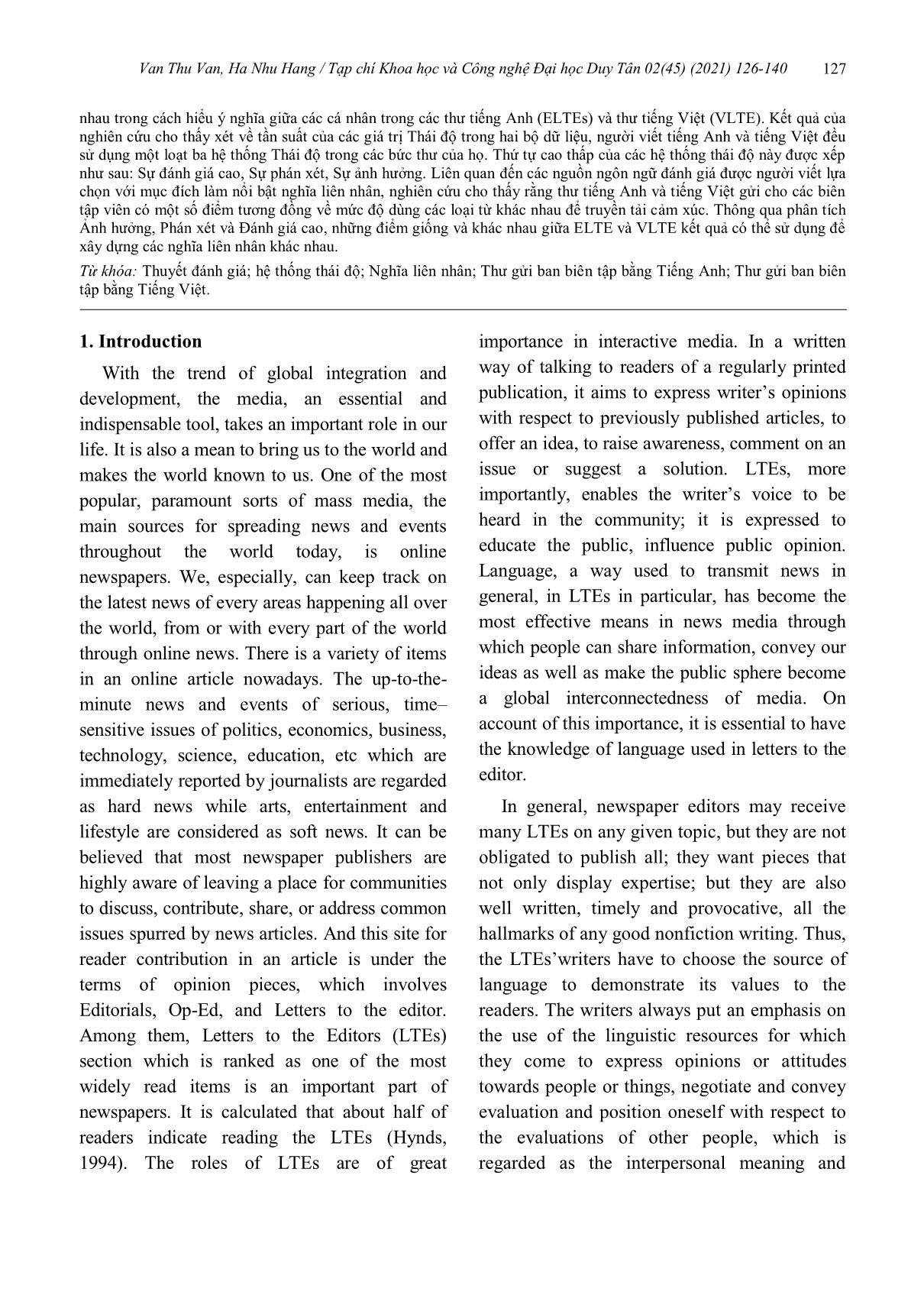
Trang 2
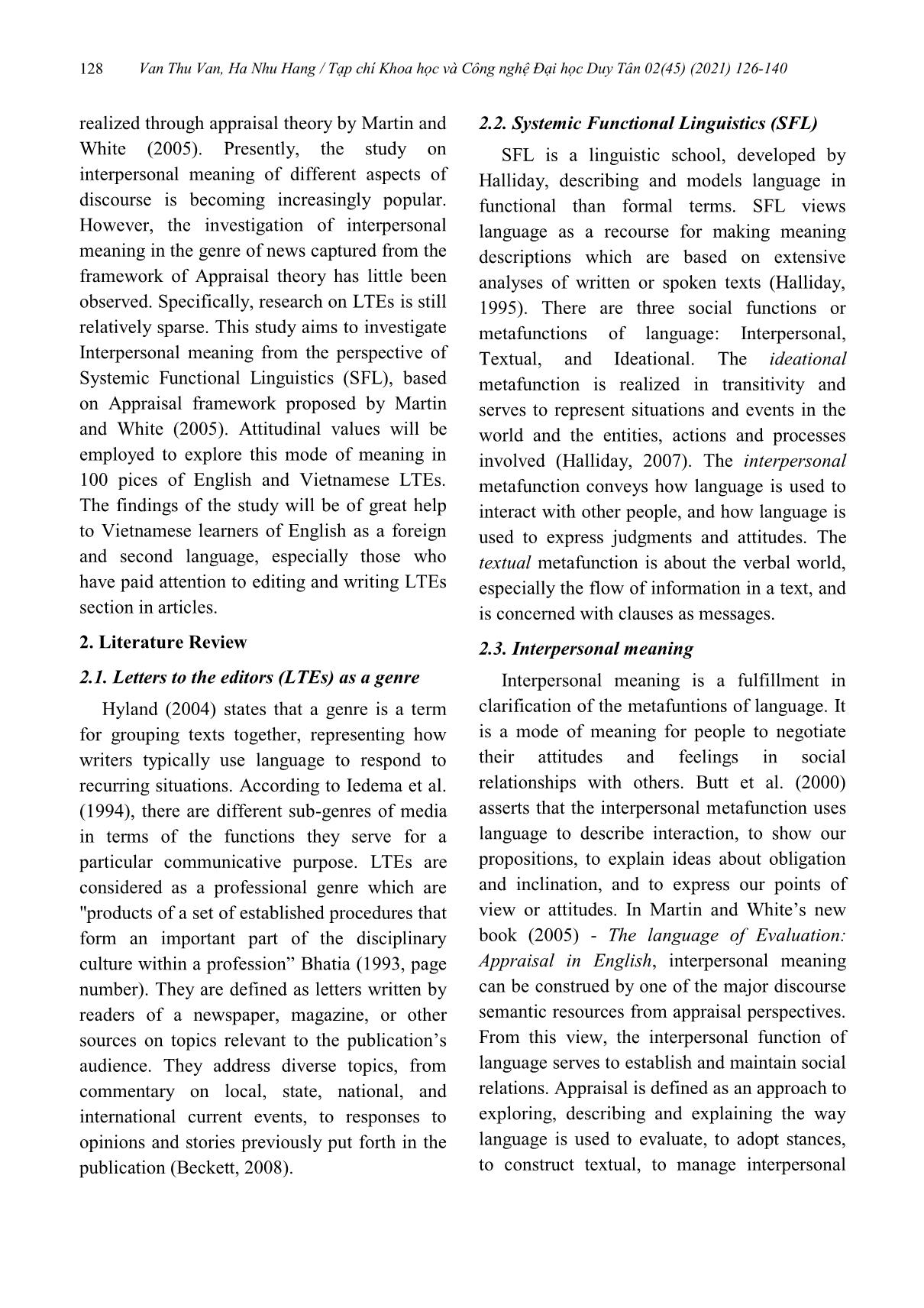
Trang 3
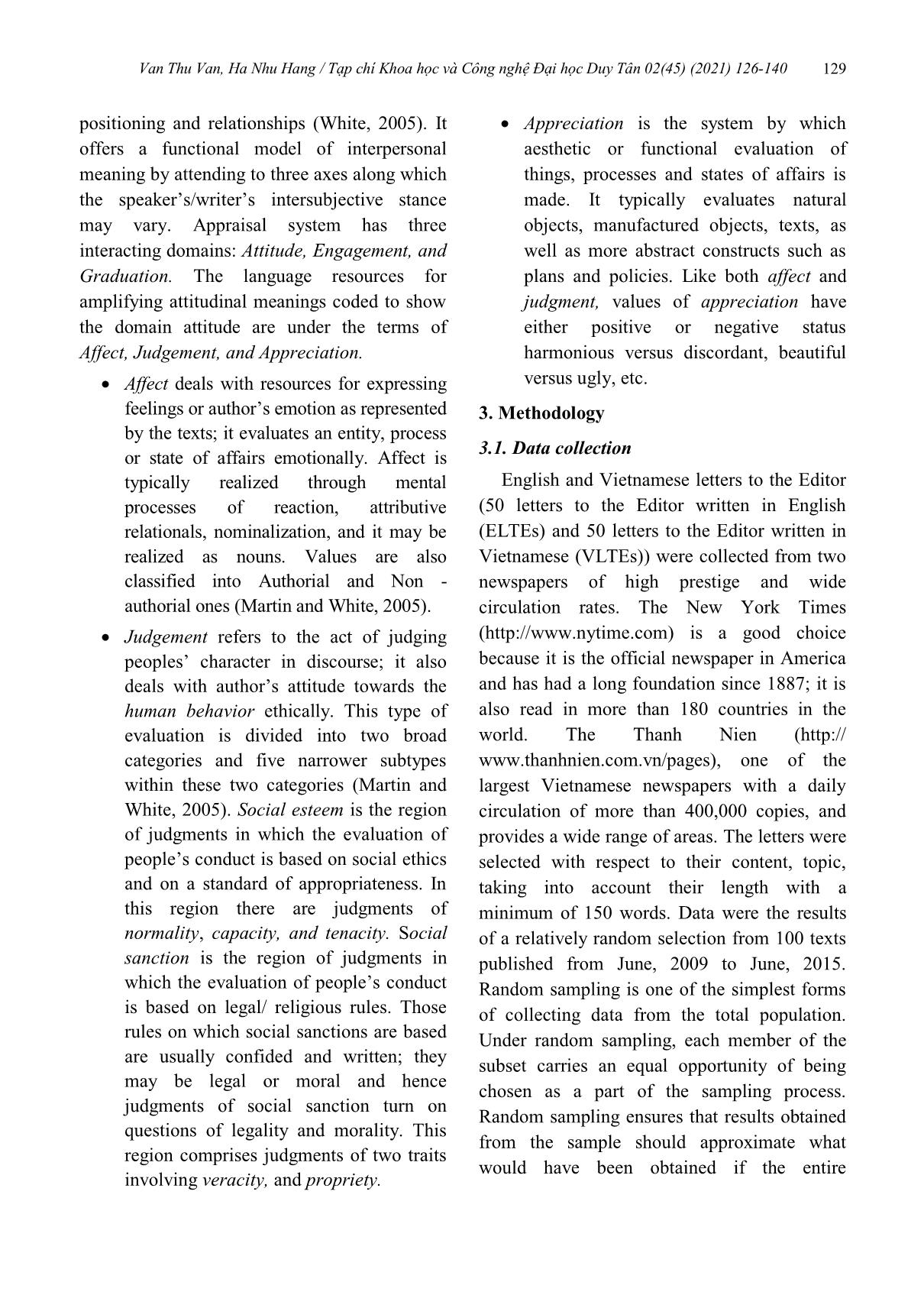
Trang 4
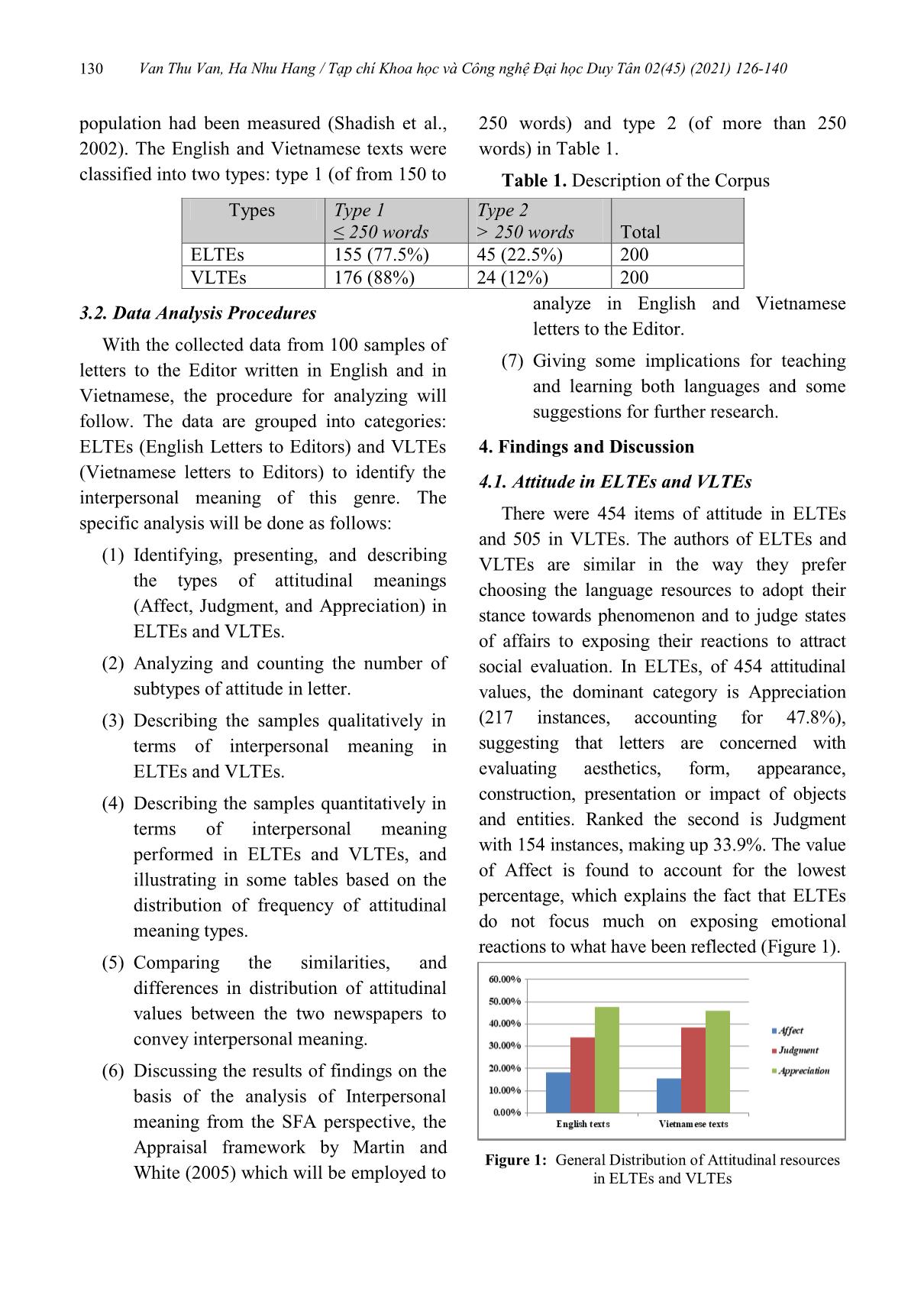
Trang 5
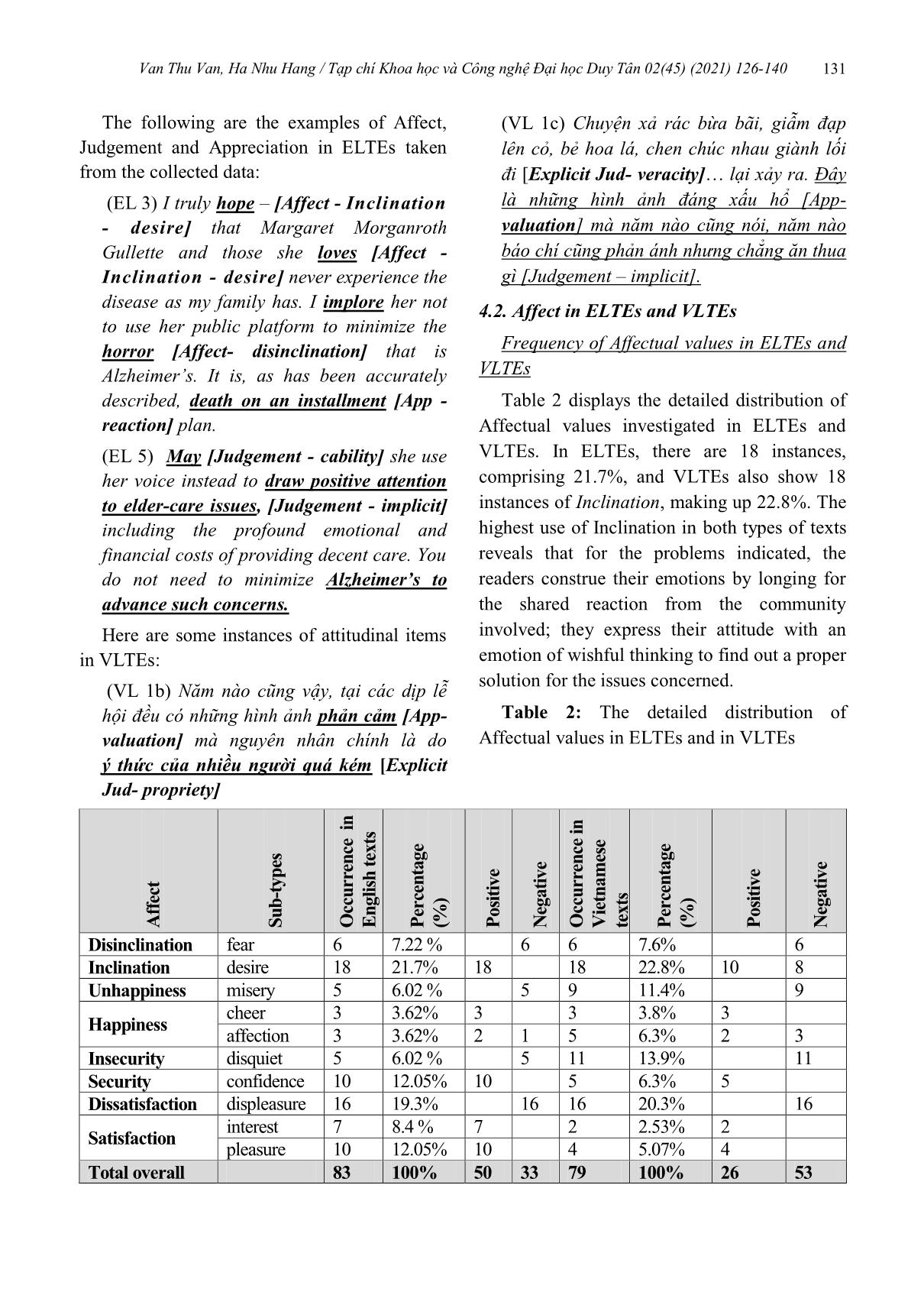
Trang 6
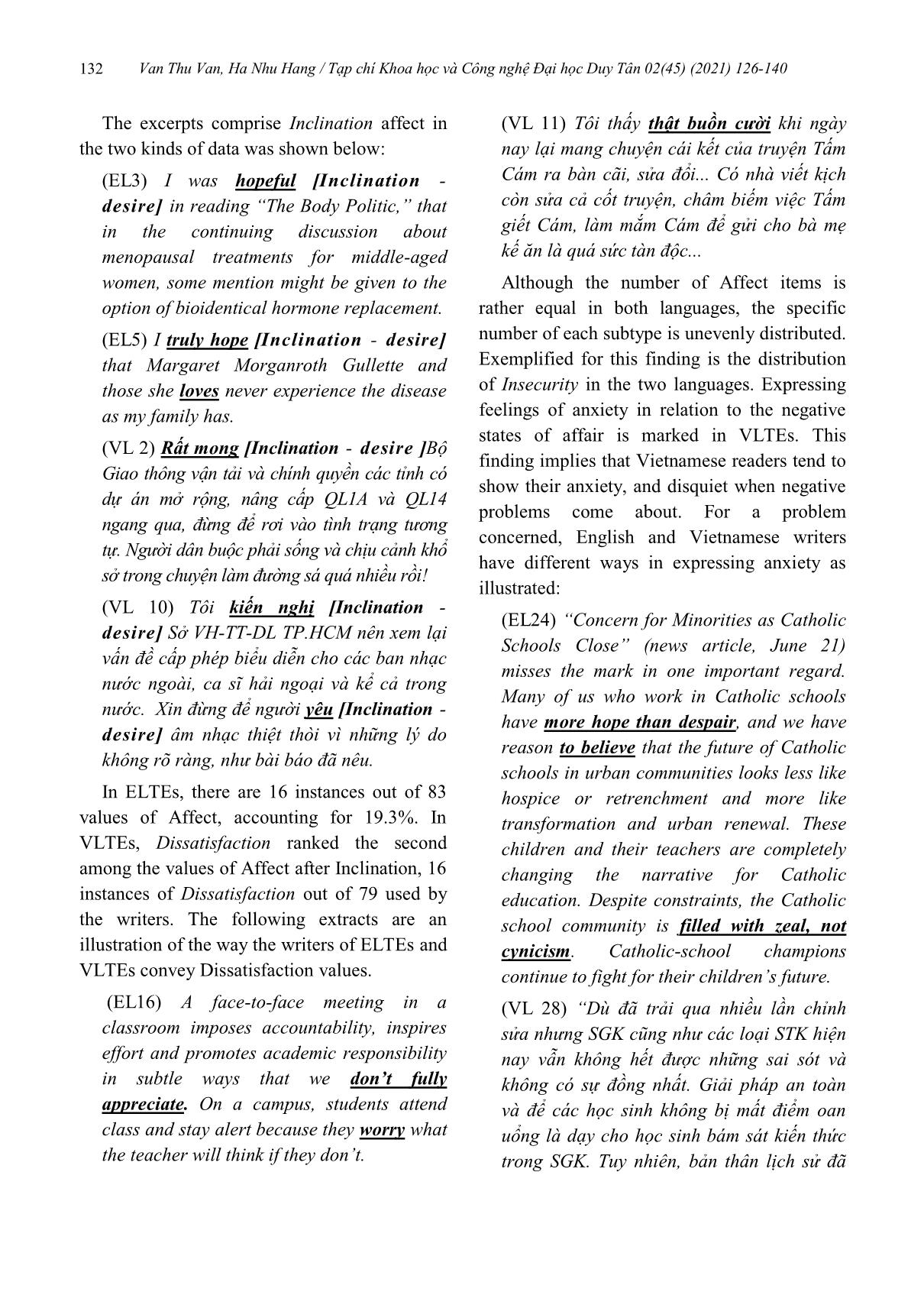
Trang 7
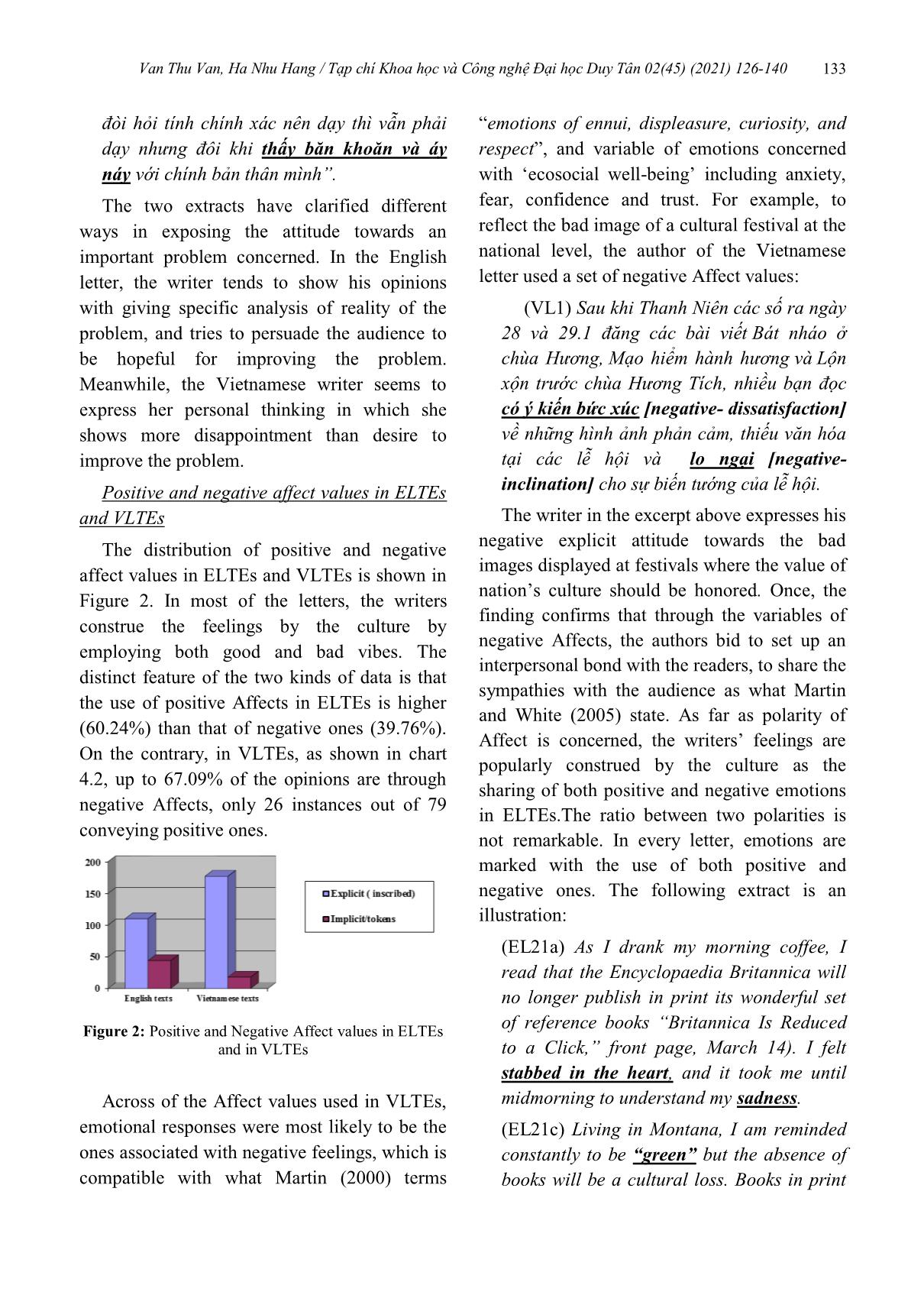
Trang 8
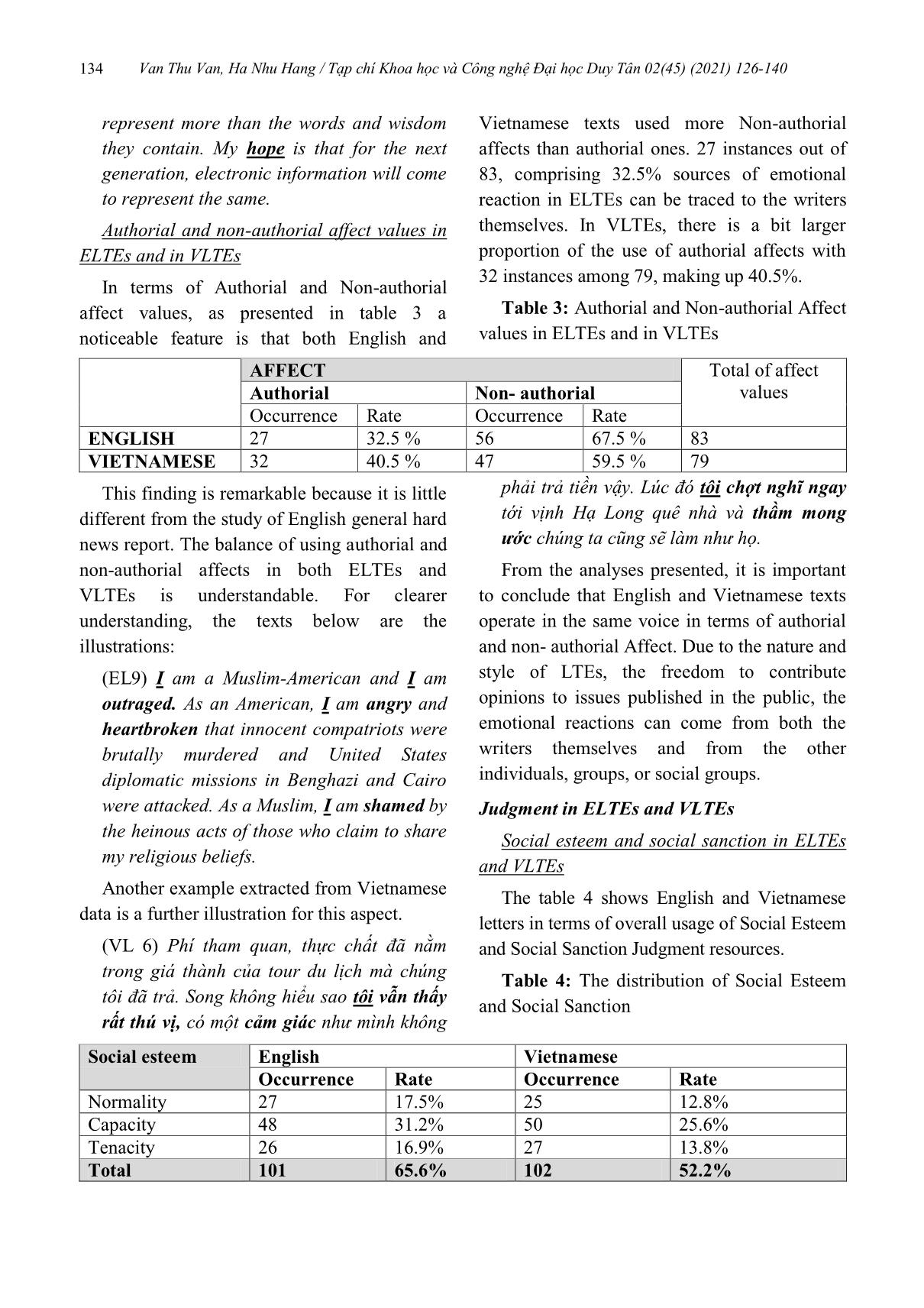
Trang 9
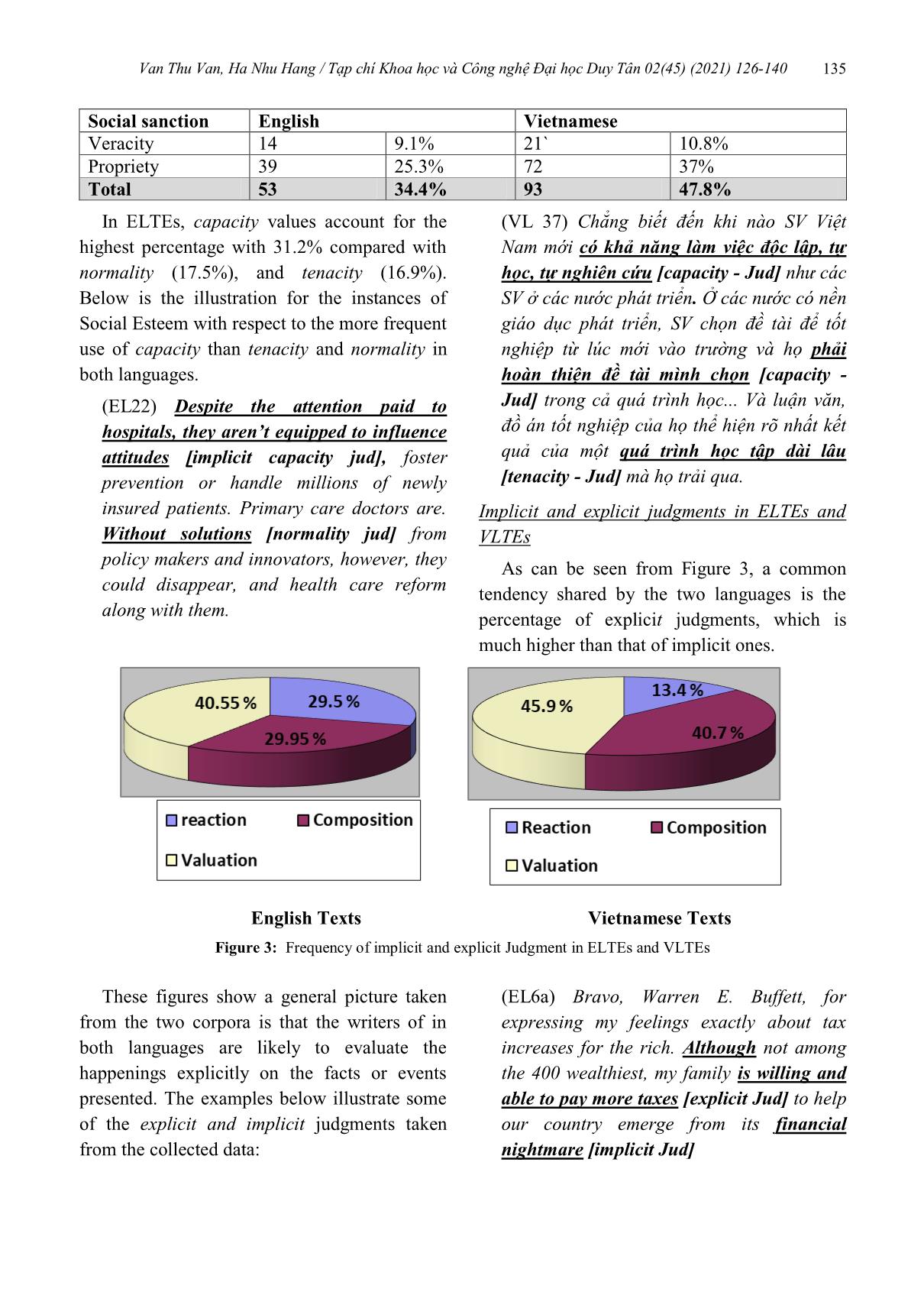
Trang 10
Tải về để xem bản đầy đủ
Tóm tắt nội dung tài liệu: Phân tích nghĩa liên nhân trong chuyên mục phản hồi của độc giả gửi ban biên tập bằng tiếng Anh và tiếng Việt theo thuyết Đánh giá
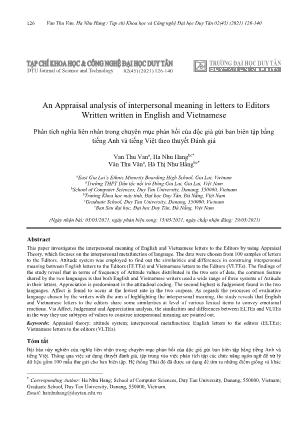
n cỏ, bẻ hoa lá, chen chúc nhau giành lối đi [Negative Jud] lại xảy ra. Đây là những hình ảnh đáng xấu hổ mà năm nào cũng nói, năm nào báo chí cũng phản ánh nhưng chẳng ăn thua gì. Extract 4: (VL 4) Các cơ quan chức năng địa phương làm gì [Negative Jud], có xử lý hay làm ngơ [Negative Jud] cho bến xe dù hoạt động? Trách nhiệm [Negative Jud] trước hết của tình trạng này thuộc cơ quan chức năng địa phương và lực lượng CSGT. In extract 1, judgement items ‘unfairly neglected or unaware of’, ‘fall between the cracks’ are negative values, and only one positive item ‘to deal with’ is employed. Two sides of polarity interplay to reflect the reality of incapacity and the way Congress did to solve Van Thu Van, Ha Nhu Hang / Tạp chí Khoa học và Công nghệ Đại học Duy Tân 02(45) (2021) 126-140 137 that problem. A mix of negative and positive assessment passed on the Congress to persuade the readers to place their positions at a certain stage to give solution to the situation. Similar to extract 1, extract 2 conveys an interpersonal position between the readers and the writer through a positive judgment ‘right’ and a negative one ‘wrong’ to evaluate the act of David L. Kirp. In the same way, VLTEs’ authors show their assessments in a combination of negative and positive judgment. However, Vietnamese letters’ writers would rather express the weak points than give the praises. Most of the Judgment values in letters are negative ones. In extract 3, ‘ý thức của nhiều người quá kém’, ‘xả rác bừa bãi’, ‘giẫm đạp lên cỏ’, ‘bẻ hoa lá, chen chúc nhau giành lối đi’ are expressions conveying negative judgments criticizing the unconscious behavior of visitors to Huong Pagoda. Additionally, a lot of negative judgments used in extract 4 are aimed at evaluating the irresponsibility of officials related, and influencing public opinions directly. Appreciation in ELTEs and VLTEs Frequency of appreciation values in ELTEs and VLTEs The overall distribution of Appreciation and its subtypes found in the two corpora. In ELTEs, there are 88 instances of valuation, accounting for 40.55% of the total Appreciation values; the second highest is composition with 65 instances, which constitute 29.95%; reaction with 64 instances, making up 29.5%. The Vietnamese counterparts show the same pattern of valuation use that is, the valuation (45.9%) with 106 instances, composition (40.7%) with 94 instances, and reaction (13.4%). Both sets of data are coded with valuation which reflects the worth, significance of things appraised. This similarity in the two languages shows a common interest in the evaluation of their social significance in relation to culturally or ideologically established conventions. The examples below are evident for the dominance of values of Appreciation performed in the two languages: (EL17) While online shopping may not always offer the precise level of personalization Ms. Ephron requires, it is a growing [valuation] part of retailing - and for good [valuation] reason. It offers convenience, saves time, adds value and provides access to goods and services [valuation] that might otherwise be difficult to obtain. (VL 7) Tôi tự hỏi, với bộ máy nhà nước dày đặc [composition]từ Trung ương đến địa phương như thế tại sao lại để “lọt” được những hàng hóa “rác” [valuation] như thế? Mà có phải lọt ít đâu [composition] hàng loạt container chứ không phải một hay vài ký. Với sự kiểm soát lỏng lẻo, thiếu chuyên nghiệp, vô trách nhiệm [composition] như thế thì ai biết liệu còn những hàng hóa nguy hiểm [valuation] nào sẽ lọt vào Việt Nam, khi ấy hậu quả là khôn lường [valuation]. As with valuation, reaction appreciations have to do with the degree to which an entity, process, or phenomenon capture our attention and the emotional impact it has on us. In terms of this reaction values, VLTEs contain fewer items than ELTEs. (EL5) If only it were simply a fear of forgetting [Reaction - impact]. Alzheimer’s is so much more [Reaction- impact]. It is, in our case, a comatose [Reaction - impact] state with eyes wide open and the experience of watching a kind and funny man become an agitated, angry and afraid person with no connection to the world in which he sits (because he cannot stand or walk anymore). Van Thu Van, Ha Nhu Hang / Tạp chí Khoa học và Công nghệ Đại học Duy Tân 02(45) (2021) 126-140 138 In the English example, many reaction values of Appreciation are displayed by the writer. Here, the author uses evaluative resources to describe the emotional impact of Alzheimer’s (a serious disease) on the readers. In VLTEs, the amount of the reaction appreciation is too small, only 31 instances per 50 texts. (VL 12) Việc VNPT, Vinaphone ban hành quyết định kỳ quặc này không những xâm phạm quyền lợi của đại lý mà còn xâm phạm nghiêm trọng quyền lợi khách hàng, là những người đã mua sim/kit của Vinaphone nhưng chưa sử dụng. Khi mua sim/kit trả trước, khách hàng không hề được thông báo thời hạn bắt buộc phải kích hoạt cũng như việc nếu không kích hoạt sim sẽ bị hủy. Sẽ có hàng ngàn khách hàng bị ảnh hưởng [Reaction - impact]. nếu quyết định này đi vào thực tế. Hiện nay, không chỉ Vinaphone, VNPT có cách làm lạ đời như thế, một số nhà mạng khác cũng chẳng vừa, khách đã mua sim và đã dùng, nhưng vì lý do riêng, vài tháng khách không sử dụng sim thì bỗng nhiên số bị cắt, bán cho người khác, khiếu nại [Reaction-quality]. Another interesting feature found from the examples in both sets of data is the Appreciation valuations and compositions embedded within evoked Judgment values. Instances of Appreciations at one level contribute to the representation of Judgment at another. This phenomenon is performed in the English example below. (EL12) Clearly, this is a serious [App/Composition - Jud / capacity] matter that must be handled in a professional [App/Valuation - Jud / capacity] manner. There are lives at stake [Composition] in addition to TV ratings. (EL3) We certainly acknowledge that what is warranted in this situation is a sincere [App/Reaction - Jud/ veracity] apology - but not a generalized [Valuation] defamation of an efficient and valuable [Valuation] way of shopping today. Similarly, this feature is also realized in the Vietnamese data: (VL 1) Sau khi Thanh Niên các số ra ngày 28 và 29.1 đăng các bài viết Bát nháo ở chùa Hương,Mạo hiểm hành hương và Lộn xộn trước chùa Hương Tích, nhiều bạn đọc có ý kiến bức xúc về những hình ảnh phản cảm, thiếu văn hóa [Reaction - quality] tại các lễ hội và lo ngại cho sự biến tướng [Valuation] của lễ hội. Appreciation reaction referring to quality demonstrates the bad images happening at festivals where there should have been significant values of culture represented. Additionally, appreciation valuation evaluates the criticism of the bad act done by irresponsible and unconscious people. From this instance, it is noted that different sub- types of Appreciation (valuation and reaction in the examples above) are embedded within invoked Judgment. In other words, instances of these appreciation values represent of some kinds of other Judgment. Positive and negative appreciation in ELTEs and VLTEs Vietnamese have significantly higher frequencies of negative Appreciation items than positive ones. Only 60 instances out of 231 values of Appreciation convey positive assessements on events, process, products or the happenings. English shows a more balanced pattern in appraising entities. There are 110 instances of positive values, making up approximately 50 % like negative ones. Van Thu Van, Ha Nhu Hang / Tạp chí Khoa học và Công nghệ Đại học Duy Tân 02(45) (2021) 126-140 139 (EL38) In “Honor Code” (column, July 6), David Brooks writes that in the Western world, “the education system has become culturally cohesive, rewarding and encouraging a certain sort of person: one who is nurturing, collaborative, disciplined, neat, studious, industrious and ambitious.” And this is a complaint! (VL 28) Dù đã trải qua nhiều lần chỉnh sửa nhưng SGK cũng như các loại STK hiện nay vẫn không hết được những sai sót và không có sự đồng nhất. Giải pháp an toàn và để các học sinh không bị mất điểm oan uổng là dạy cho học sinh bám sát kiến thức trong SGK. Tuy nhiên, bản thân lịch sử đã đòi hỏi tính chính xác nên dạy thì vẫn phải dạy nhưng đôi khi thấy băn khoăn và áy náy với chính bản thân mình. Theoretically, the present study is expected to reaffirm the importance of Systemic Functional Grammar in analyzing and understanding online news, letters to the Editor as a genre, a class of communicative events, the members of which share some set of communicative purposes. Moreover, it will hopefully provide scholars who are interested in Appraisal with the enrichment of knowledge of evaluation language, by which an Appraisal analysis shed light on the interpersonal meaning. Practically, our findings may offer some advantages and be instructive for writing and teaching letters to the Editor column in an article, a discourse of media genre. 5. Conclusion and Implications Our comparative analysis of Attitudinal meanings, especially of the three systems (Affect, Judgment and Appreciation), shows that there are similarities and differences in the ways the writers of ELTEs and VLTEs express their attitude to convey interpersonal meanings. Appreciation is predominant in the attitudinal coding. The second highest is Judgement found in the two languages. Affect is found to occur at the lowest rate in the two corpora. These findings indicate that there is a common tendency of the normative assessment of human behavior and assessment of forms, aesthetics, and system of social values rather than evaluations by means of disclosure of personal emotions to the phenomena mentioned by the writers of both languages. However, our analysis shows a difference in the rate of distribution of subcategories in each language. The English writers pay attention to both negative and positive sides of the problem to invite the audience to have an argument. On the contrary, Vietnamese writers put emphasis on the effect of what is going on, what is right, what is wrong, and trace to the responsibility of individual and group involved. The finding is very meaningful for both teachers and students in teaching and learning reading, academic writing and journalism. For the language teaching, this study may emphasize the need of teaching students to exploit the evaluative linguistic resources in writing skill, especially skill of writing academic texts, articles, and LTEs in an effective way. Further, language and culture are two important elements in making a successfully interactive relation in cross – cultural interactions. Thus, the findings will help students express their attitudinal meanings in public with a polite strategy and focus them on choosing the linguistic resources to express assessments with argumentative and informative attitude. For journalism students, understanding and mastering language used in writing genre is very necessary and challenging. The way the students employ evaluative language to express objective viewpoints embedded in their pieces of writing based on various cultural aspects is very important. Specifically, the ability to do Van Thu Van, Ha Nhu Hang / Tạp chí Khoa học và Công nghệ Đại học Duy Tân 02(45) (2021) 126-140 140 judgments and associate emotional responses with participants and processes deployed in either spoken or written form is of great importance. LTEs genre is a type of opinion news in public where language resources are evaluated with high criteria involving objectiveness, depth, accuracy, completeness, source reliability, newsworthiness, interactivity, and trustworthiness. Therefore, values of attitudinal meanings play an important role in helping the writers choose the effective resources of persuasion exposed in the public news texts. For scholars, especially linguistic scholars, this small study contributes a humble part to knowledge of evaluative language. Moreover, the present study is expected to reaffirm the importance of Systemic Functional Grammar in analyzing and understanding online news and letters to the Editor as a genre, a class of communicative events. The study was limited to LTEs in English and in Vietnamese in terms of interpersonal meanings based on Appraisal analysis. One of the restrictions of this thesis is the limited number of letters (100 in total). The future research should employ a wider range of selected LTEs. In addition, Attitude is the only one system investigated among the three ones in relation to Appraisal Theory. It is of great relevance and importance for future research to employ Engagement and Graduation as a tool to explore interpersonal meaning. Finally, as far as interpersonal meaning is concerned, it is more adequate for a research to employ Mood and Modality analysis as well. References [1].Beckett, C. (2008). Supermedia: Saving Journalism So It Can Save the World. Malden MA: Wiley- Blackwell. [2].Bhatia, V. K. (1993). Analysing genre: language use in professional settings. London: Longman [3].Bloor, T. & Bloor, M. (1995). The Functional Analysis of English. A Hallidayan Approach. London: Edward Arnold. [4].Butt, B., R. Fahey, S. Feez and C. Yallop. (2000). Using Functional Grammar: An Explorer’s Guide. Macquarie University: National Centre for English Language Teaching and Research. [5].Eggins, S. (1994). An introduction to systemic functional linguistics. London: Continuum Wellington House. [6].Eggins, S. 2004. An Introduction to Systemic Functional Linguistics (2nd Edition). London: Continuum. [7].Halliday, M.A.K (1995). An introduction to Functional Grammar. London: Edward Arnold. [8].Halliday, M. A. K. (2007). Language and Education. London: Continuum. [9].Hynds, E. C. (1994). Editors at most U.S. dailies see vital role for editorial page. Journalism Quarterly, 71, 573-582. [10]. Hyland, K. (Ed.). (2004). Genre and second language writing. Ann Arbor, MI: University of Michigan Press. [11]. Iedema, R., Feez, S., and White, P.R.R. (1994). Media Literacy. (Write it Right’Literacy in Industry Research Project – stage 3). Sydney: Metropolitan East Disadvantaged Schools Program, NSW Department of School Education. [12]. Martin, J. R., & White, P. R. R. (2005). The Language of Evaluation: Appraisal in English. New York: Palgrave Macmillan.
File đính kèm:
 phan_tich_nghia_lien_nhan_trong_chuyen_muc_phan_hoi_cua_doc.pdf
phan_tich_nghia_lien_nhan_trong_chuyen_muc_phan_hoi_cua_doc.pdf

